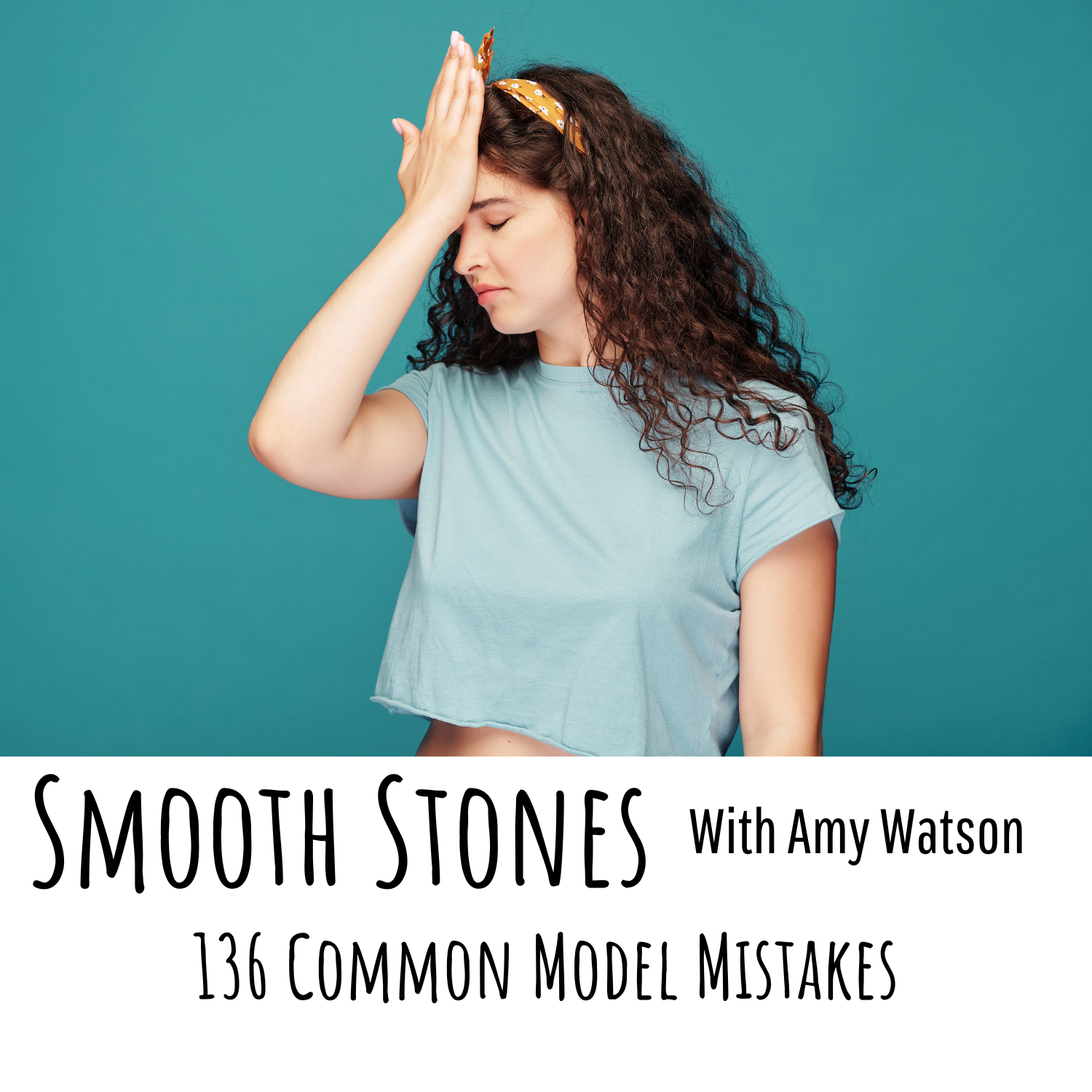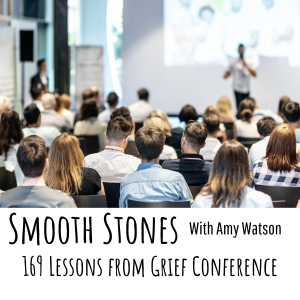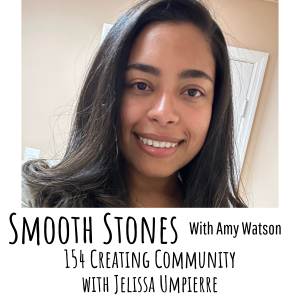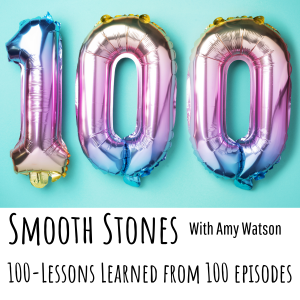The self coaching Model is life changing, but there are some common mistakes I see my clients making that I want to help you avoid. Once you can see what’s happening in your mind with full clarity, nothing can stop you! Listen in to find out how to get the best results ever with just a few simple changes.
To get support from Amy, click HERE
Follow me on Instagram! @amy.smoothstonescoaching
Visit my website.
Photo by Canva
Music by ZingDog on Pond5
Transcription
What is up Friends, how are you doing? I. It’s funny, I’m kind of having a day. I’m feeling a little. Like I’m dragging my feet, but also I’m so excited and I want you to know that that’s okay. You can be multiple things all at once. I’m really, really excited to talk about this topic because it comes up a lot and I really wanna help you get your models going so that you can coach yourself.
Now if you’ve been here for a long time. You know about the model? The model is the main coaching tool that I use, um, that I learned when I trained at the Life Coach school with Brooke Castillo. She’s the creator of the model, and it literally changes lives. It changed my life, and it’s just a way to look at the way you’re thinking and figure out what is going on and why.
You’re feeling the way you are and why you have the results you have in your life. Um, it’s really similar to cognitive behavioral therapy if you’ve done that before, but it’s a little bit different. So go back to episode seven. If you have not listened to episode seven, or you haven’t listened for a while, This is where you need to go to learn the basics of the model.
And then I am going to talk about some common model mistakes that I see people doing and it’s, it’s common like, The model is really simple, but there’s things that we do that kind of make it not work as well as it could. And the goal always with models is just awareness. A lot of times people jump right ahead and I guess this is one of the big mistakes, is we jump ahead to thinking that we can use self-coaching or we can use models just to get rid of our negative emotions and so we don’t have to feel bad or, um, Like if we just put it things in a model, we can just force it to happen.
But really what we want is awareness and we want clarity. That’s what’s really, really important, and it’s important to me when I coach you, I have done. Like thousands and thousands and thousands of models and learned this over and over. So I am really good at doing these models and I can help you in coaching with this, but this is gonna help you with your self coaching.
So listen, and I’m going to again, try to keep this really simple, really clear so that you’re like, oh. That’s why I’m not getting the answers that I need. I’m not making the progress that I wanna make. It’s because I’m just doing this little thing that everybody does when they’re first learning the model.
So no worries if you felt a little bit stuck. Uh, you are right where you’re supposed to be. So the basics of the model, although like I said, go back to episode seven, the basics of the model. Are there five lines each one? Has a name and a lot of times we shorten that name down to a letter, so it’s circumstance, thought, feeling, action, result.
And we call this C T F A R. When we write a model, we usually just write C T F A R. We fill in each of these lines. Circumstance is just the facts of the situation. The, the facts of what we’re dealing with. Thought is just that. It’s a thought. Um, our feeling is how we feel when we think that thought. Our actions are what we do when we’re feeling that way or what we don’t do.
Cuz a lot of times we avoid, um, doing things and then our result is. What we get when we act that way. And it kind of is the, the culmination of this model and the result always ties back to the thought and the result is always about us. And so I just want to talk about why this is so important. We go through our lives having, like, there’s different theories.
I’ve heard like 60,000 thoughts a day, just a lot of thoughts during the day, and a lot of the thoughts that we have are unconscious thoughts because if everything we are doing was conscious, like we would not be able to function If you’re noticing everything, if you are paying attention, um, to just every little detail.
You wouldn’t be able to function. So our brain notices new things, but then it learns. So, um, an example is like if you move to a new town, when you first moved to a new town, like everything is hard. You’re really paying attention. You’re like, where was the bank again? And, and which street do I turn down to get to my house?
And, um, Who lives in that thing, like I can’t, you know, you’re like really, really paying attention to all the details and it’s a lot of work. But once you’ve lived in a town for a while, like we lived in the town we live in for seven years, like I can pretty much get anywhere on autopilot. I know where everybody lives.
I know how to get to most places. So my brain has kind of downgraded how to get to the elementary school. Because I don’t need that to be top of mind. I can just have it, you know, running in the background. And that’s what happens with a lot of our thoughts. So we pick up beliefs that we’re taught. We pick up ideas, we pick up things, we think about ourselves, and after a while we don’t even notice them.
We just take them in and we file them away and they’re just running in the background of our brain. The model helps pull those out. The model helps us see why we’re really struggling, why we’re feeling terrible, why we cannot let go of our grief or forgive ourselves. And the first thing that we need to do, um, to get a good model is a thought download.
A thought download is where you just take a piece of paper and a pen and you write, and you do not stop writing and you don’t edit. And you can give yourself a certain amount of time or a certain amount of paper, like, I’m gonna write one page without stopping, or I’m gonna write five minutes without stopping.
We just wanna brain dump out all our thoughts. When we have those thoughts, that’s what we’re gonna be able to put into the model. So I, I don’t wanna repeat too much, like I said, go back to how to coach yourself. There’s two kinds of models. We have an unintentional model and that is where. This is just happening in the background and we’re just pulling it out kind of after the fact.
We’re seeing what’s happening. We’re noticing those unconscious thoughts, and then there’s an intentional model, and that’s the one where we can put anything we want in the result line. We get to make this up. Like how do we wanna feel? How do we wanna think, what do we wanna do? What do we wanna accomplish?
That’s our intentional model. So we’ll, we’ll have the unintentional model and sometimes we call that a, um, when we’re writing. Um, And that’s just like awareness of what’s happening. And then the intentional model is one that we decide ahead of time what we want to create. And those are so incredibly powerful.
But we definitely don’t wanna skip the unintentional model cuz when we can find the thoughts that are blocking us, that’s where we make so much progress. So I’m gonna add this bonus. I didn’t have this one written down, but one of the biggest mistakes I see is people trying to skip. The unintentional model or trying to go to an intentional model too fast, right?
We just like, I don’t wanna feel this way, or I don’t want this problem to keep happening. I just wanna figure this out. And so they try to jump. Ahead and it just doesn’t stick. It doesn’t change the behavior because we haven’t uncovered what’s holding us back. And it could be a thought, it could be like our nervous system is too activated, we don’t feel safe enough, we don’t feel like comfortable with our intentional model.
There’s lots of things that can be blocking us. So really important to stay with that unintentional model. Feel the feelings, stop trying to avoid it. Um, and it, things are just so much better when you don’t try to skip or rush that step. Okay? The first problem I see a lot is that our circumstance is not neutral.
Now, when we say circumstances are neutral, lots of times people want to argue with that. So what I, the word I usually use is factual. Circumstances are facts. For example, if you had a miscarriage, which pretty much everyone here has, um, you can put that in your circumstance. Like, my baby’s heart stopped beating at 14 weeks.
That is a fact. So we wanna take out all the subjective language. We wanna just put in facts. Maybe if you’re mad at God, you might try to put. God took my baby away in the circumstance. And that feels really true. It feels like a fact in your mind, but it’s not true. It’s too full of like opinions and ideas and things that we cannot prove that happened.
And so what I would do in that circumstance or in that in this situation, if you are trying to do a model and you’re feeling like God took my baby away, that is a thought. That’s not a circumstance. So your circumstance would be what I said before, my baby’s heart stopped beating at 14 weeks. That is a fact that most of us can prove approximately.
We might not have all the details, but um, that’s, that’s a fact, right? And then our thought is, God took my baby away. And then that will, when we think that thought, how do we feel? That’s gonna show you how you feel, how you’re showing up and what your result is. So make sure that your circumstance is neutral, that it only has facts, that you take out all the subjective words and really bring it back.
Um, you can use quotes. You can use, like if someone said something to you, you can quote them, but just don’t add any of your opinions onto the circumstance. That’s really, really important if you wanna get clarity in your model, cuz if your circumstance. Isn’t factual, the rest of your model is kind of gonna be messy and complicated.
The next one is we sometimes try to put a positive thought on a negative circumstance, so we might have gotten our circumstance factual. . Like on paper, but in our head we still think it’s negative and then we try to put a positive thought on it. And this is the part where we’re probably rushing if we haven’t allowed ourselves to process through and, and recognize what’s happening in our unintentional model.
So I will give you another example. I, the other day actually, it continues. We’re at the end of April and it is still freezing and it keeps snowing and it will not stop snowing where I live, so I could have, there is frozen precipitation on the ground outside my house at 7:00 AM When I wake up, I look out the window, I see snow, but when I put that really factually, I’ll just say at 7:00 AM there’s frozen precipitation on the ground.
Uh, I could be really upset about this, right? So my unintentional thoughts might be like, I hate this. This is the worst, all the things. But a lot of times what we will try to do is go to an intentional model and we’ll still have that frozen precipitation on the ground. But we wanna put a happy thought on it, like, This will be so good.
We needed this water. We’ve been in a drought, right? We try, and this is why people do this to us. We know this as grievers, like our baby dies, and people want to put a positive spin on that. So they will offer us their thoughts like, oh, they’re in heaven, or They’re an angel now. Or, you know, at least it wasn’t later.
Those are all attempts to put a positive thought on. Like a negative circumstance and it doesn’t stick is the problem. As long as that circumstance feels really heavy, you’re not gonna be able to just put a positive thought on it. So that’s why we need to stay in the unintentional model, figure out what’s going on, see what thoughts and feelings we have so that we can address them rather than try to bypass them.
Because really the truth is, If I notice this snow, I can be mad about it. I can stay mad. Even I can, you know, complain to all my friends and, and whatever it is. But if I allow myself to be frustrated or disappointed or whatever I’m feeling. Because it feels like it’s never going to be spring. I will process those emotions.
I will stay with them, and they will go away just as fast as this little bit of snow is going to melt if I try to skip it and try to be grateful for the precipitation, because we’ve been in a drought, I’m really just pushing away my own feelings, and that’s why it’s so, so important not to do that.
Another one I see is what we call jumping models. This is. Really similar to where we want to, we’re starting our model and we’re a little bit in the negative part. And then so we’ll have our circumstance, our thought, our feeling, and then in our action we will jump out of it and we’ll try to basically fix it in the middle of our model.
And I see this a lot in, let’s say, um, Your house is kind of messy. So we have a, a circumstance that like, there’s 40 things on the counter in my kitchen, and your thought is, you know, I am the worst housekeeper ever. And you feel terrible. And then in your action you would say, set a timer, put on some music, get everything cleaned up.
And your result is the kitchen is clean. That is jumping models. The way you were thinking and feeling is really gonna lead to a different result where you’re, you know, still feeling terrible about yourself. You would have another model where your thought is, I can get this done and it’s gonna create a different feeling and it’s gonna create those actions of setting a timer, having a dance party, you know, getting it done.
And, and we just need to be aware of that because especially when you start self coaching, you’re gonna wanna. Get out of the negative thoughts and feelings, and sometimes we do this just within a model and, and you’ll wonder like, why isn’t this clear? Why isn’t this making sense? Um, this isn’t quite adding up and it’s hard to create an intentional model because you’ve already got half of it in your first unintentional model.
Okay. Then another real common one is that we have too many thoughts. Like I said, we’ll do a thought download and we will have, I know maybe you have 50 thoughts on paper, or you have all these thoughts running around in your head that you haven’t written down yet, and sometimes we will just put them all in a model.
Each model needs to have one thought, so one circumstance, one thought, one feeling. That’s really, really important. Each thought gets its own model. This is, again, the point is awareness. If we have a whole bunch of thoughts, We won’t know what feelings, cause we’re gonna have a whole bunch of feelings and then we’re gonna have a whole bunch of different actions and it’s gonna be a really messy result at the end.
Another one is we, we go to the intentional model and our thought doesn’t feel believable. So in the intentional model we do sometimes we say we wanna go unicorns and daisies and, and really big beliefs, especially if you are setting goals. You wanna do the impossible. You wanna set impossible goals, but sometimes it feels really out of reach.
It doesn’t feel aligned, it doesn’t feel believable. But what I wanna tell you, if you’re doing this, if you’re doing some models and you’re in maybe like a really dark place, when you really wanna find some hope and you wanna look forward with faith, and you wanna believe that good things are coming, It’s okay that they feel really far apart.
Um, you can’t see my hands right now, but pretend I’m showing you how big a fish is, I’m just holding my hands out. It feels so far apart. But you have this unintentional model where you are and you have this intentional model where you want to be. This space in between is the magic. That is the growth, that is the process.
We don’t wanna skip that middle part either We. We wanna set goals that are kind of unbelievable because the whole world tells us we should be realistic and we shouldn’t set big goals and, and that there’s not hope and I just don’t believe it. I don’t. Like anything is possible. You can do whatever you want.
You can create whatever you want. I absolutely believe that. So in that space, don’t worry about it. Now, if you are feeling like a thought just isn’t believable, it doesn’t feel right, try it on. Um, check it out. If you don’t like it, just get rid of it. Try something else and keep trying stuff until it feels.
Good to you, or it feels like maybe it’s possible I could get there and if it feels really far, of course, we can use what we call ladder thoughts. If we’re talking about, I had a miscarriage and your thought is, I’m never gonna be happy again, and your unicorns and rainbows thought is, I’m gonna have a beautiful happy life.
And that just doesn’t feel real yet. You can start by thinking, maybe I could just find 10 minutes of happiness in this day, or maybe I can give myself some hope. Maybe it’s possible that I can be happy again. Or you could look at someone who inspires you and say, they’ve found happiness. Maybe I can do it too.
So you wanna have these little ladder thoughts that will help you get there all along the way. You don’t have to make a big, huge, impossible jump. So that’s really, really important. Okay. One other quick thing that I see a lot is your result isn’t your result. The result always has to be about you. It can’t be about your partner or your kids, or your doctor, or your family or your, you know, any of those things.
It needs to be about you. Because this is all about self-awareness, self-coaching, and your results in your life that we do have more control over than we think. So make sure in your result you’re not trying to manipulate anyone or make them act a certain way or make anything happen that isn’t within you.
Now again, saying, I believe we can put anything in the result line as long as it’s focused on you. This, all of this is what you’re gonna learn in coaching. This model is so powerful when you can finally figure out what is going on in your brain, when you can learn how to clean up your thoughts, when you can learn how to see things differently, and how to set ridiculous, impossible, unrealistic goals and put them in your result line, it is.
The absolute best. I love it so much and I use it every day just to notice like, what am I thinking? What am I doing? Why am I doing it right? And when you know the model really well, you also can learn to just love yourself in your models. Cuz we don’t need to judge ourselves. We don’t need to be mad. Uh, this is all just the process of being a human and trying to up-level yourself, right?
Just be a little bit more aware, be a little bit more intentional, and see what changes. I have to tell you, I have been working so hard to create some new programs for you. They’re really, basically what I was doing before coaching my clients, but I’ve just. Refined it and defined it, and I’m adding some resources and so I have two programs that are almost ready to go.
I have the LIFT program, which is for anyone Living Life After Loss, we’re gonna help you lift up your eyes, find yourself again. It’s so beautiful. And then I have my Pregnancy After Loss Peace program, which. Pregnancy after loss is just is so hard. It was really hard for me. So I have created a program that is everything I wished that I had.
So if you are living life after loss or you are pregnant after loss, you need to go to Smooth Stones coaching.com. You can check out what’s happening over there. I’ve got everything in there. If you go to the get support page, You will see these programs and I will be taking some new clients starting in June.
I’m so excited. If you wanna be in on it, get in on it. I don’t have that many spots. Um, I want you to get your time to feel better, to learn how to coach yourself, to learn how to take care of your nervous system, and just find that hope and that joy again. I’ll see you next time. Are you tired of feeling like your baby’s death was somehow your fault?
Go to Stones coaching.com and get my free mini course. How to Stop Blaming Yourself After Loss.




